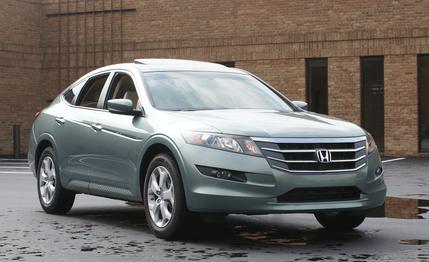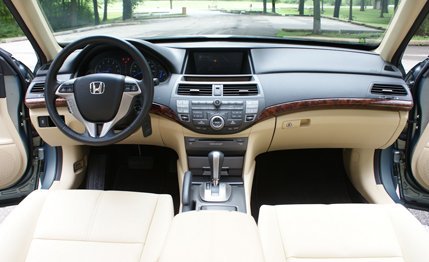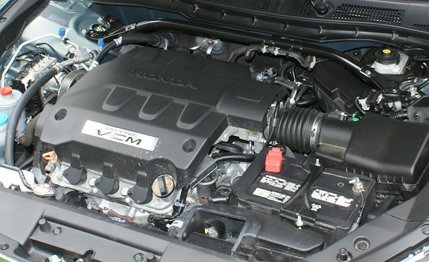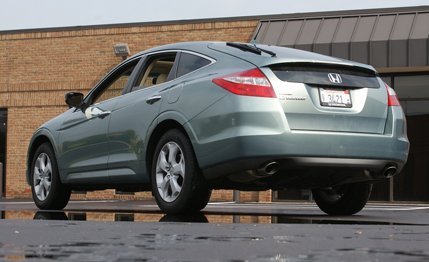 Short Take Road Test
TESTED
Short Take Road Test
TESTED
As the philosopher Jagger said, “You can’t always get what you want.” Mick was right. What we want—what we’d love—is a Honda Accord station wagon. But Americans don’t buy wagons. Rather, some Americans buy some wagons, just not in high enough numbers to convince automakers to give us more traditional load luggers. Instead, Honda—like every other carmaker—sells crossover utility vehicles: car-based, raised wagons meant to look more like SUVs and less like Clark Griswold’s family truckster. The Accord Crosstour is the company’s entry into the somewhere-between-sedan-and-SUV segment, an Accord-based answer to Toyota’s Venza.
We previously tested an all-wheel-drive Crosstour, but this front-drive version is significant because it’s the closest to a regular V-6 Accord sedan. Be forewarned, though, that they’re siblings, not twins. For the Crosstour, the engineers at Honda increased the ground clearance to a Toyota Venza–matching 8.1 inches versus 5.7 for the Accord sedan. The hunchbacked Crosstour is two inches wider than an Accord sedan and roughly 300 pounds heavier. Because of the large cargo area, the Accord Crosstour is left looking like a sunbathing cetacean. Fortunately for the Crosstour, all this added junk in the trunk has only a modest fuel-economy penalty, with the front-wheel-drive Crosstour rated at 18 mpg in the city and 27 mpg on the highway versus 19/29 for an Accord V-6 sedan.

That comparison is apt, because under the hood you’ll find the same refined 3.5-liter six-cylinder as in the Accord V-6 sedan (no four-cylinder is available on the Crosstour), making 271 hp, and the same five-speed automatic transmission. At some point, Honda will have to keep up with the Joneses (or the Toyotas, GMs, and Fords) and offer a more bragworthy six-, seven-, or 8-speed gearbox, but the truth is that five are plenty here. The Crosstour’s gearbox is smooth, and the gears are spaced well enough for zipping away from stoplights as well as comfortable, quiet cruising on the highway.
Decent Power, Slower Steering
The Crosstour dispatches 60 mph in a respectable 7.2 seconds, the same 0-to-60 figure turned in by the all-wheel-drive version, which was 200 pounds heavier but aided by its off-the-line traction advantage. Like the Accord sedan’s, the Crosstour’s steering is light but direct. The steering ratio has been increased, though, which kills some of the precision, and the Crosstour’s rack feels less talkative, too. The ride is comfortable, but the handling is as disappointing as you’d expect from a vehicle seemingly inspired by the top-heavy, high-riding Imperial Walkers from Star Wars. In brisk cornering, there is significant body roll, and urgent braking will toss your cargo like a salad.

The interior is similar—if not identical—to the Accord sedan’s ahead of the second row. The instrument panel and the dash are shared, and that means the Crosstour is blessed with the same well-assembled, high-grade plastics as in the sedan. Unfortunately, this also means that, as in the current Accord sedan, drivers of the Crosstour must set sail on a sea of gray buttons seemingly organized to satisfy someone obsessed with symmetry rather than ergonomics. We believe that the navigation system, a $2200 option in our test car, is based on the same model that was standard on the Nina, Pinta, and Santa Maria. It has antiquated map graphics and slow input, and it was unable to find several locations that popped up instantly on a smartphone loaded with Google Maps.
And Now for the Bad News
But all of that—the stuff shared with the conventional Accord—is actually the good news. We get to the bad stuff when evaluating the Crosstour’s unique aspects, largely the cargo area. Go by the spec-sheet volume numbers, and all seems well. With the rear seats folded, the Crosstour can handle 51 cubic feet of cargo volume, a huge jump over the 14 cubic feet of trunk space in the Accord sedan. Of course, the sedan’s rear seats fold to swallow more stuff, but the open hatch of the Crosstour is more practical for larger items.
In practice, though, the cargo area is compromised by vertical plastic monoliths that hide the rear shock towers. They severely bite into the available width, meaning you can only take advantage of the Crosstour’s full 51.3 cubic feet of cargo volume if you’re hauling, say, a ginormous, shape-conforming bag of water. You could also carry many, many smaller items—400 canned hams, for example—arranged to fill the entire space.

It doesn’t get better. Visibility is just tolerable to the direct rear, with the sloping backlight providing a slim viewing area. Honda’s designers fitted a second, lower tinted-glass window, à la Toyota Prius (or Honda’s own Insight and CR-Z), which helps a bit, but that means there’s a big crossbar where the two pieces of glass meet. A rearview camera helps when backing up, but it comes only with the woeful navigation system. The Crosstour’s blind spots are gargantuan, too, the result of seriously chubby D-pillars. It’s not that you can’t see what’s in the blind spots; it’s that you have to be outside the car to do so.
Finally, the brakes have been swiped from the smaller, lighter CR-V, and the Crosstour’s extra weight makes them work extra hard for results that are merely adequate. Our tested stopping distance (70-to-0 mph took 188 feet) was comparable to the Toyota Venza’s, but the Crosstour’s brakes were prone to fade. We’re not talking about a problem that calls for congressional hearings, but stopping is not a confidence-inspiring affair.
All of this adds up to a compromised vehicle. Our tester came in at $3695 more than a comparable Accord sedan but doesn’t drive nearly as well, and the extra utility promised by the hatchback is actually pretty limited. Mick may have said, “You can’t always get what you want,” but he followed that optimistically with, “If you try sometimes/You might find/You get what you need.” And he was right. For shoppers in this category, it’s called the Pilot or CR-V.